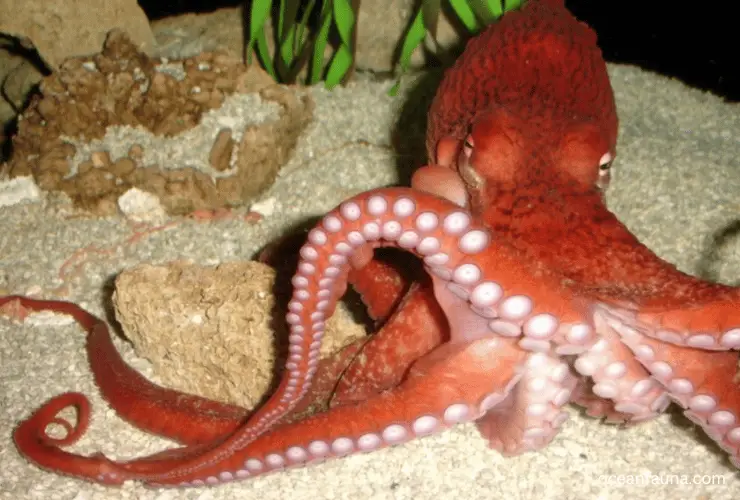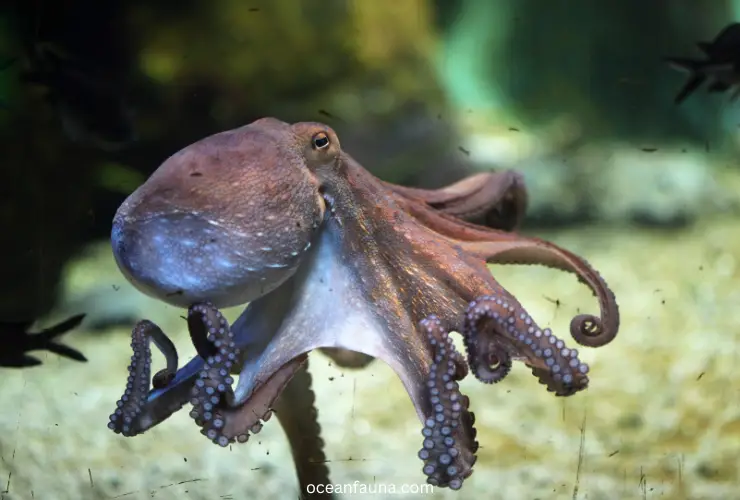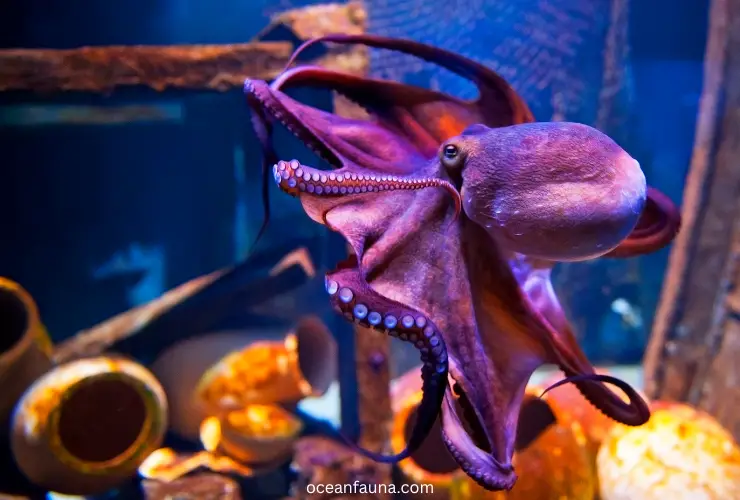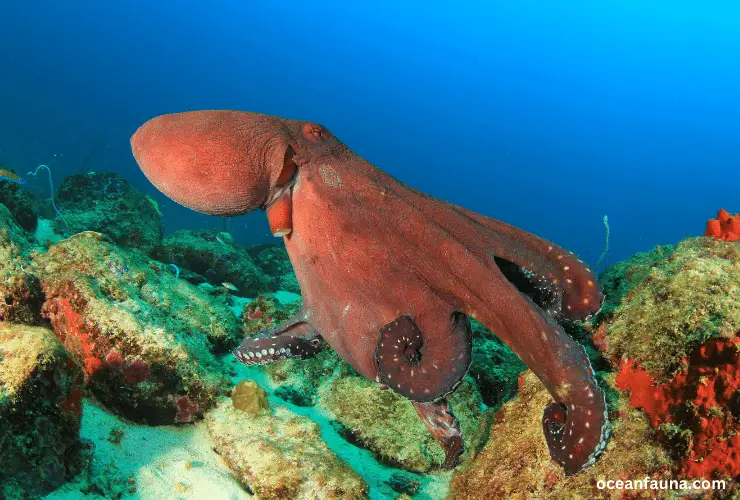From a forum, I got to know that people are asking and discussing, “Do octopuses have 3 hearts, 9 brains, and blue blood?” And this blog will discuss all this from an anatomical point of view.
The octopus is a type of mollusc with eight limbs belonging to the order Octopoda within the class Cephalopoda. This order has around 300 species. Although some facts about their biology are distorted in popular culture, the anatomy of octopuses is intriguing. They have unique anatomical features that distinguish them from other species.
Let’s discover how many hearts and brains octopuses have, including their blood colour.
Do Octopuses Have 3 Hearts: Yes, But Why?
Octopuses have three hearts, a unique characteristic of these intelligent creatures. Each of these hearts serves a specific purpose and works together to keep the octopus alive and functioning properly.
Anatomically, the octopus’s three hearts are located in different parts of the body. Two of the hearts are in the gills, while the third is in the central body cavity.

The two peripheral hearts are responsible for pumping blood to the gills, where oxygen is picked up from the water. This oxygenation process is vital for the octopus to survive since it needs to breathe underwater.
After the peripheral hearts have pumped the oxygenated blood through the gills, the central heart takes over and circulates the blood to the rest of the body. This heart provides energy to various organs and muscles, allowing the octopus to move, hunt, and survive. Without these three hearts working together, the octopus would not be able to survive in its aquatic environment.
One interesting fact about octopuses’ hearts is that they beat at different rates. The central heart beats slowly and steadily to provide a constant flow of oxygenated blood to the organs and muscles.
On the other hand, the peripheral hearts beat faster to pump the deoxygenated blood to the gills for oxygenation.
Do Octopuses Have 9 Brains: Yes, But Why?
Octopuses have 9 brains, each with a specific function. These brains are located throughout the octopus’s body, and this distributed nervous system is known as a decentralized nervous system.
Octopuses have three hearts, and their blue blood is pumped by a heart just for that purpose. The unique anatomical structure of their nervous system and body allows octopuses to control their arms and perform complex actions such as opening jars, using tools, and escaping from predators.
The central or main brain is responsible for processing major sensorimotor functions, learning, and memory. It is located in the head and is doughnut-shaped.

From the central brain, two optic lobes extend to process visual information from the eyes and control the arm, while the third lobe processes olfactory information coming from the octopus’s nostrils.
The remaining eight brains are called ganglia, each of which is responsible for controlling a specific arm. The nerves from the arms connect directly to the respective ganglia, enabling each arm to act independently but still receive information from the central brain. This allows for localized control over each arm and coordinated movements of multiple arms.
Moreover, octopuses have remarkable regenerative abilities and can regrow limbs. When an octopus loses an arm, the ganglia corresponding to that arm can grow a new arm. This decentralized nervous system also helps protect the octopus from predation since the others can continue to function autonomously if one arm is bitten off.
Do Octopuses Have Blue Blood: Yes, But Why?
Yes, octopuses have blue blood, and the reason is due to the presence of a copper-rich protein called hemocyanin. Hemocyanin is a crucial molecule that enables octopuses to transport oxygen throughout their body, similar to how humans use haemoglobin.
However, unlike haemoglobin, which contains iron, hemocyanin contains copper, giving the blood its blue colour.
The oxygen-carrying function of hemocyanin works in a slightly different way than in haemoglobin. In octopuses, hemocyanin is dissolved in the blood and is not contained within red blood cells like haemoglobin.
Instead, the copper molecules in hemocyanin bind to oxygen as it enters the octopus’s body, forming an unstable compound that can be easily broken down by the cells that need oxygen. This allows for a more efficient oxygen transfer from the lungs to the cells throughout the octopus’s body.
Interestingly, the blue colour of octopus blood also provides a unique advantage for these sea creatures. In cold environments, like Antarctica, where the temperatures can drop below freezing, the high copper content in their hemocyanin allows it to remain fluid even at sub-zero temperatures.
This ensures the octopuses can continue to transport oxygen and survive in adverse conditions where other animals may not be able to.
Do All Octopuses Have 3 Hearts, 9 Brains and Blue Blood?
Yes, all octopuses have three hearts, nine brains and blue blood. The three hearts help to circulate the oxygen-rich hemocyanin throughout their body, while the nine brains control different aspects of an octopus’s behavior, such as movement, breathing and feeding.

And the blue colouration in their blood is due to the presence of a copper-rich protein called hemocyanin which allows the octopus to transport oxygen efficiently even in cold temperatures. All of these unique adaptations have allowed octopuses to become one of the most successful and widespread ocean creatures on Earth.
FAQs
Can an octopus brain perform if one arm is lost?
Yes, an octopus’s brain can perform even if one of its arms is lost. This is because an octopus’s nine brains are decentralized and not tied to any one particular limb.
Anatomically, an octopus’s nervous system comprises a central brain and eight smaller clusters of neurons, or ganglia, located in each of its eight arms. These ganglia allow each arm to move and sense the environment independently and also function to integrate sensory information with the central brain.
When an octopus loses an arm, its body immediately begins the process of regenerating the lost limb. Hemocytes, specialized immune cells, migrate to the site of the injury and form a clot to prevent excessive bleeding.
The cells then initiate the tissue growth and differentiation process, with specific cells specializing in forming the various components of a new arm, including muscle, connective tissue, and nervous tissue.
The nervous tissue in the new arm is formed from specialized cells called neuroblasts, which differentiate into neurons and then extend axons to form synapses with existing neurons in the adjacent ganglion.
Over time, the new neurons become functionally integrated into the pre-existing nervous system, allowing the octopus to regain full control and sensation of all its remaining limbs.
Remember, while octopuses can regenerate lost limbs, the process is not immediate and can take several weeks or months, depending on the size of the arm and other factors. In addition, the regenerated arm may not be exactly the same as the original in terms of size, shape, or function, although it will still be fully capable of performing tasks and activities.
Is there anything special about octopuses’ blood?
Yes, octopuses have a unique adaptation in their blood, allowing them to survive in cold environments. Their copper-rich hemocyanin gives it a blue colouration and allows it to transport oxygen more efficiently than haemoglobin found in warm-blooded animals.
This adaptation allows octopuses to survive and thrive in cold, deep ocean environments where other animals may not be able to. This makes them one of the most successful and widespread creatures on Earth.
Conclusion
So, hopefully, you have a detailed understanding that octopuses have 3 hearts, 9 brains (one is central), and blue blood (due to the hemocyanin).
You also learn that they can regenerate lost limbs, including muscles, connective tissue, and nervous tissue. This amazing ability to regrow an arm is incredible and is still being studied today.
Not only are these creatures fascinating in their anatomy, but they also play a vital role in the ocean’s ecosystems. Let me know if you have any queries about this ocean creature.

